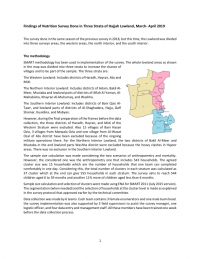Findings of Nutrition Survey Done in Three Strata of Hajjah Lowland, March- April 2019
The survey done in the same season of the previous survey in 2018, but this time, the Lowland was divided into three surveys areas, the western areas, the north interior, and the south interior.
The methodology
SMART methodology has been used in implementation of the survey. The whole lowland areas as shown in the map was divided into three strata to increase the chance of villages and to be part of the sample. The three strata are:
The Western Lowland: Includes districts of Haradh, Hayran, Abs and Midi.
The Northern Interior Lowland: Includes districts of Aslam, Bakil AlMeer, Mustaba and lowland parts of districts of Aflah Al-Yaman, AlMahabisha, Khayran Al-Muharraq, and Washha.
The Southern Interior Lowland: Includes districts of Bani Qais AlTawr, and lowland parts of districts of Al-Shaghadera, Hajja, Qofl Shamar, Kuaidina, and Mabyan.
However, during the final preparation of the frames before the data collection, the three districts of Haradh, Hayran, and Midi of the Western Stratum were excluded. Also 15 villages of Bani Hasan Ozla, 3 villages from Matwala Ozla and one village from Al-Wasat Ozal of Abs district have been excluded because of the ongoing military operations there. For the Northern Interior Lowland, the two districts of Bakil Al-Meer and Mustaba in the and lowland parts Washha district were excluded because the heavy clashes in Hajoor areas. There was no exclusion in the Southern Interior Lowland.
The sample size calculation was made considering the two scenarios of anthropometry and mortality. However, the considered one was the anthropometry one that includes 543 households. The agreed cluster size was 15 households which are the number of households that one team can completed comfortably in one day. Considering this, the total number of clusters in each stratum was calculated as 37 cluster which at the end can give 555 households in each stratum. The survey aims to reach 544 children aged 6 to 59 months and another 11% more of children aged less than 6 months.
Sample size calculation and selection of clusters were made using ENA for SMART 2011 (July 2015 version). The segmentation (when needed) and the selection of households at the cluster level is made as explained in the survey protocol that approved earlier by the technical committee.
Data collection was made by 6 teams. Each team contains 3 female enumerators and one male team head. the survey implementation was also supported by 3 field supervisors to assist the survey manager, one logistic officer, and four data entry and management staff. All these members have been trained one week before the data collection process.

